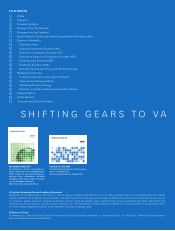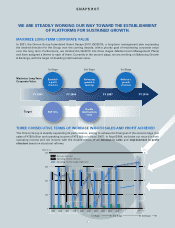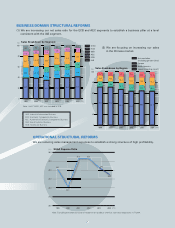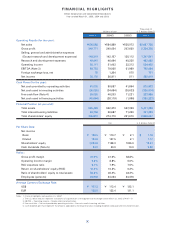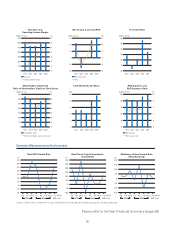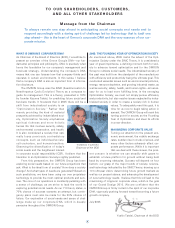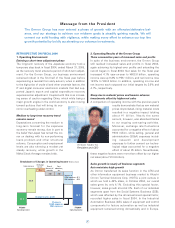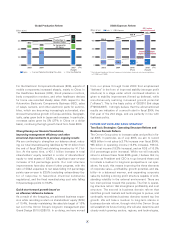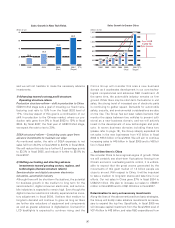Omron 2005 Annual Report Download - page 8
Download and view the complete annual report
Please find page 8 of the 2005 Omron annual report below. You can navigate through the pages in the report by either clicking on the pages listed below, or by using the keyword search tool below to find specific information within the annual report.
6
Message from the Chairman
TO OUR SHAREHOLDERS, CUSTOMERS,
AND ALL OTHER STAKEHOLDERS
WHAT IS OMRON’S CORPORATE DNA?
As Chairman of the Board of Directors (BOD), I would like to
present an overview of the Omron Group’s DNA—our fun-
damental principles and philosophy. DNA is precisely what
forms the foundation for our company’s management and
business strategy. Understanding the company’s DNA
means that one can foresee how that company thinks and
operates in certain environments. In this sense, I believe
that a company’s DNA is also an important form of informa-
tion disclosure.
The OMRON Group uses the SINIC (Seed-Innovation to
Need-Impetus Cyclic Evolution) Theory as a compass to
guide its management. This is a theory, presented in 1970
by founder Kazuma Tateisi, for predicting future social and
business trends. It forecasts that in 2005 there will be a
shift from industrialized society to an
“Optimization Society.” Rather than
merely providing the kind of material
prosperity achieved by industrialized soci-
ety, Optimization Society emphasizes
spiritual richness and more holistic
human life that involves security, safety,
environmental conservation, and health.
It is also considered a society that opti-
mally fuses previously contradictory
concepts, such as individual/society,
culture/nature, and human/machine.
Observing the diversification of today’s
social needs and the heightened interest
in corporate social responsibility (CSR), I believe that the
transition to an Optimization Society is rightly predicted.
From this perspective, the OMRON Group has been
exploring social needs based on our future projections that
ask: What is the ideal form of society? How does a society
change? And what types of needs are generated? Based on
such predictions, we have been using our own proprietary
technology to provide the most optimal products and serv-
ices. The core of our operations is constantly pulsating with
a sense of challenge, as we strive to lead the world in
exploring potential social needs. As our 7:3 theory states, a
70% chance of success warrants an attempt, but contin-
gency plans must also be made for the 30% chance of
failure. Our exploration of social needs and sense of chal-
lenge make up our corporate DNA, which is deeply
pervasive throughout the OMRON Group.
2005: THE FOUNDING YEAR OF OPTIMIZATION SOCIETY
As mentioned above, 2005 marks the advent of the Opti-
mization Society under the SINIC Theory. It is considered a
year of great importance, a defining moment both for soci-
ety to advance toward optimization and for the OMRON
Group to cultivate social needs. The industrialized society of
the past was built from the standpoint of the manufacturer
with efficiency and productivity being the ultimate goal. This
overlooked essential issues such as environmental pollution,
energy, resource depletion, and growing industrial waste, as
well as security, safety, health, and human rights—all neces-
sary for us to lead more fulfilling lives. In the emerging
Optimization Society, we must not simply pursue efficiency
and productivity, but also resolve issues neglected by indus-
trialized society in order to create a society rich in human
values. To adequately meet this goal, it is
time for us now to begin taking action in
earnest. The OMRON Group will mark this
turning point for society as the Founding
Year of Optimization and steer its efforts
in a new direction.
MAXIMIZING CORPORATE VALUE
Turning our attention to the present eco-
nomic environment, the volatile exchange
rates, sudden rise in crude oil prices, and
many other factors adversely affect cor-
porate performance. While it is important
that we deal with these issues, the pres-
ent concern is whether we can steadily shift gears to
establish a future platform for growth without being held
back by oncoming obstacles. Success will depend on four
factors: our grasp of the major trends of society, science,
and technology indicated by the SINIC Theory; drawing up a
10 to 20-year vision; determining future growth markets as
well as our present stance; and advancing the development
of new technology needs. I believe that this will lead to the
maximizing of long-term corporate value, which is the goal
of our Grand Design 2010. We are confident that the
OMRON Group is firmly rooted in the spirit of our corporate
DNA, vigorously pushing forward toward becoming a future
growth company.
July 2005
Yoshio Tateisi, Chairman of the BOD
To always remain one step ahead in anticipating social concepts and needs and to
respond accordingly with a daring spirit of challenge led by technology that is itself one
step ahead— this is the heart of Omron’s corporate DNA and the very essence of our cor-
porate mission.
YOSHIO TATEISI
Chairman of the BOD


